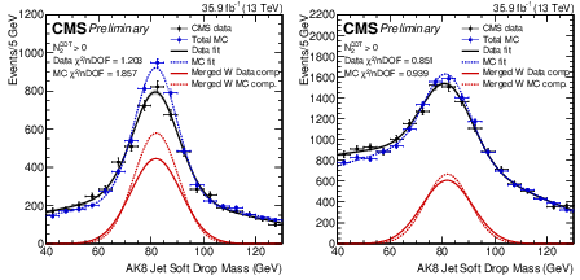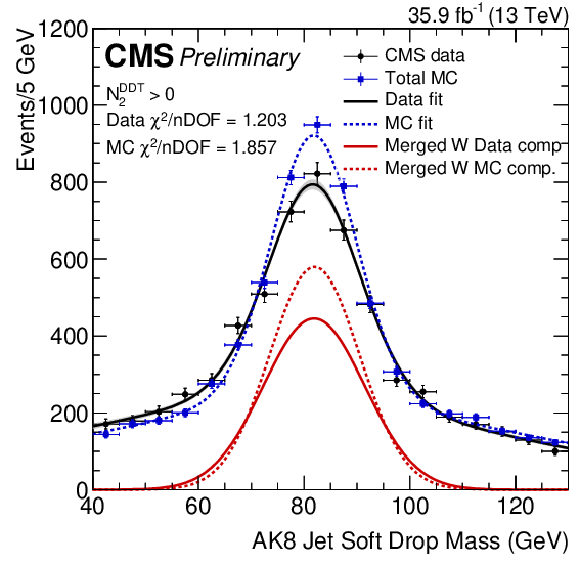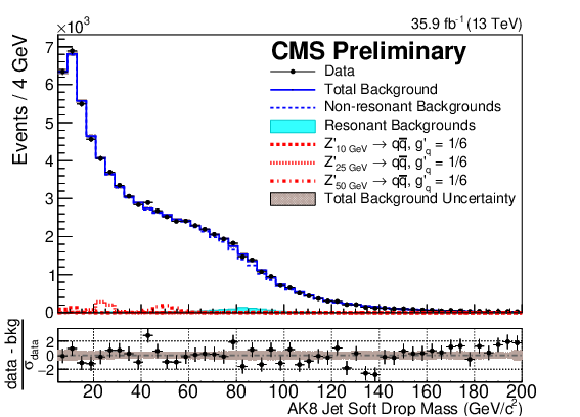

Compact Muon Solenoid
LHC, CERN
| CMS-PAS-EXO-17-027 | ||
| Search for boosted quark-antiquark resonances produced in association with a photon at $\sqrt{s}= $ 13 TeV | ||
| CMS Collaboration | ||
| March 2019 | ||
| Abstract: A search for narrow resonances decaying to quark-antiquark pairs is presented. The search is based on events collected in center-of-mass energy $\sqrt{s}= $ 13 TeV proton-proton collisions with the CMS detector at the CERN LHC. The data sample corresponds to an integrated luminosity of 35.9 fb$^{-1}$, collected in 2016. The search considers the case where the resonance is produced with high transverse momentum due to initial-state radiation of a photon. As a result, the decay products of the resonance are reconstructed as a single large-radius jet with two-pronged substructure. The signal can be identified as a localized excess in the jet invariant mass spectrum. No evidence for such a resonance is observed in the mass range 10 to 125 GeV. Upper limits at the 95% confidence level are set on the production cross sections of vector resonances decaying to pairs of quark, and presented in a mass-coupling parameter space. This result constitutes the first constraint of its kind in this resonance mass range. | ||
|
Links:
CDS record (PDF) ;
CADI line (restricted) ;
These preliminary results are superseded in this paper, PRL 123 (2019) 231803. The superseded preliminary plots can be found here. |
||
| Figures | |

png pdf |
Figure 1:
Fits to events passing and failing the $N_2^{\text{DDT}} < $ 0 requirement for data and MC in the ${{\mathrm {t}\overline {\mathrm {t}}}}$ control region. Both the total fit (including backgrounds) and the resonant peak of the W mass distribution which are used to extract the efficiency are shown. The dashed lines indicate MC both for the total fit and the resonant peak. The relative number of events passing and failing the cut is the efficiency of the $N_2^{\text{DDT}} < $ 0 cut, which is an explicit parameter in the fits. The ratio of these efficiencies is used as a scale factor to correct the efficiency in MC and the uncertainty is retained as a nuisance parameter. |

png pdf |
Figure 1-a:
Fits to events passing and failing the $N_2^{\text{DDT}} < $ 0 requirement for data and MC in the ${{\mathrm {t}\overline {\mathrm {t}}}}$ control region. Both the total fit (including backgrounds) and the resonant peak of the W mass distribution which are used to extract the efficiency are shown. The dashed lines indicate MC both for the total fit and the resonant peak. The relative number of events passing and failing the cut is the efficiency of the $N_2^{\text{DDT}} < $ 0 cut, which is an explicit parameter in the fits. The ratio of these efficiencies is used as a scale factor to correct the efficiency in MC and the uncertainty is retained as a nuisance parameter. |

png pdf |
Figure 1-b:
Fits to events passing and failing the $N_2^{\text{DDT}} < $ 0 requirement for data and MC in the ${{\mathrm {t}\overline {\mathrm {t}}}}$ control region. Both the total fit (including backgrounds) and the resonant peak of the W mass distribution which are used to extract the efficiency are shown. The dashed lines indicate MC both for the total fit and the resonant peak. The relative number of events passing and failing the cut is the efficiency of the $N_2^{\text{DDT}} < $ 0 cut, which is an explicit parameter in the fits. The ratio of these efficiencies is used as a scale factor to correct the efficiency in MC and the uncertainty is retained as a nuisance parameter. |

png pdf |
Figure 2:
Signal region after the main background estimation fit is performed. The non-resonant background is indicated by a dashed line, while the total background composed of the sum of this non-resonant background and the resonant backgrounds is shown by the solid line. Representative signals are plotted for comparison. The bottom panel shows the difference between the data and the final background estimate, divided by the statistical uncertainty on the data in each bin. The shaded region represents the total uncertainty on the background estimate in each bin. |

png pdf |
Figure 3:
95% CL upper limits on the coupling strength $g^\prime _q$ of $Z^\prime \rightarrow q\overline {q}$. The observed limit is shown in solid black, while the expected limit is dashed. The green and yellow bands are the 1 and 2 standard deviation levels. Limits from other searches and the indirect constraint from measurements of the Upsilon and Z boson width are also shown. |
| Tables | |

png pdf |
Table 1:
The systematic uncertainties included in the computation of the limit on the coupling strength of Z' to quarks. Parameters denoted by the $\star $ symbol affect both the shape and normalization of the affected distributions, otherwise, the parameter only modifies the overall normalization. The parameters affecting normalizations have log normal priors, and those affecting the shape have gaussian priors, unless marked with the $\dagger $ symbol, which denotes that this parameter was floating and constrained by the final simultaneous fit of the passing and failing distributions. |
| Summary |
| In summary, a search for low mass Z' resonantly decaying to $\mathrm{q\overline{q}}$ pairs has been presented, using data from proton-proton collisions at the LHC with $\sqrt{s}=$ 13 TeV. Jet substructure techniques and novel decorrelation techniques were implemented to search for narrow resonances over a smoothly falling background of the jet groomed mass. No significant excess were observed above the SM expectation. Upper limits were placed on the coupling strength $g^\prime_{\mathrm{q}}$ of Z' bosons with masses between 10 and 125 GeV. The results obtained below 50 GeV represent the first to be published in this mass range, providing a handle on new physics scenarios with very low masses, previously not probed by hadronic collider searches. |
| References | ||||
| 1 | Abercrombie et al. | Dark matter benchmark models for early LHC Run-2 searches: Report of the ATLAS/CMS dark matter forum | 1507.00966 | |
| 2 | G. Busoni et al. | Recommendations on presenting LHC searches for missing transverse energy signals using simplified $ s $-channel models of dark matter | 1603.04156 | |
| 3 | L. A. Anchordoqui et al. | Dijet signals for low mass strings at the LHC | PRL 101 (2008) 241803 | 0808.0497 |
| 4 | S. Cullen, M. Perelstein, and M. E. Peskin | TeV strings and collider probes of large extra dimensions | PRD 62 (2000) 055012 | hep-ph/0001166 |
| 5 | L. Randall and R. Sundrum | An alternative to compactification | PRL 83 (1999) 4690--4693 | hep-th/9906064 |
| 6 | P. H. Frampton and S. L. Glashow | Chiral color: An alternative to the standard model | PLB 190 (1987) 157 | |
| 7 | R. S. Chivukula, A. Farzinnia, E. H. Simmons, and R. Foadi | Production of massive color-octet vector bosons at next-to-leading order | PRD 85 (2012) 054005 | 1111.7261 |
| 8 | E. H. Simmons | Coloron phenomenology | PRD 55 (1997) 1678--1683 | hep-ph/9608269 |
| 9 | U. Baur, M. Spira, and P. Zerwas | Excited quark and lepton production at hadron colliders | PRD 42 (1990) 815--824 | |
| 10 | UA1 Collaboration | Two Jet Mass Distributions at the CERN Proton - Anti-Proton Collider | PLB 209 (1988) 127--134 | |
| 11 | UA2 Collaboration | A Search for new intermediate vector mesons and excited quarks decaying to two jets at the CERN $ \bar{p} p $ collider | NPB 400 (1993) 3--24 | |
| 12 | CDF Collaboration | Search for new particles decaying into dijets in proton-antiproton collisions at s**(1/2) = 1.96-TeV | PRD 79 (2009) 112002 | 0812.4036 |
| 13 | D0 Collaboration | Search for new particles in the two jet decay channel with the D0 detector | PRD 69 (2004) 111101 | hep-ex/0308033 |
| 14 | ATLAS, CMS Collaboration, M. Bauce | Search for new physics in dijet final states in ATLAS and CMS | in 5th Large Hadron Collider Physics Conference (LHCP 2017) Shanghai, China, May 15-20, 2017 2017 | 1709.04754 |
| 15 | ATLAS Collaboration | Search for low-mass resonances decaying into two jets and produced in association with a photon using $ pp $ collisions at $ \sqrt{s} = $ 13 TeV with the ATLAS detector | Submitted to: PL(2019) | 1901.10917 |

|
Compact Muon Solenoid LHC, CERN |

|

|

|

|

|

|